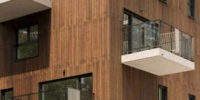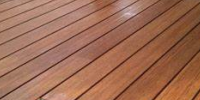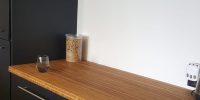








In the world of sustainable building materials, the quest for eco-friendly and innovative options is unending. One such material that has been gaining significant attention is laminated bamboo. For building material distributors, engineers, architects, and designers, understanding the advantages and disadvantages of laminated bamboo is crucial in making informed decisions. In this blog post, we will delve into the unique characteristics of laminated bamboo and explore its suitability for various construction projects.
The U.S. Green Building Council has been a strong advocate for Bamboo products for over a decade, officially since 2009 when they gave a “thumbs up” for FSC-certified Bamboo as a building material that can contribute to LEED points (read more in this article by Floor Trends Magazine). USGBC also lists CEU courses online for architects, engineers, and other industry professionals to obtain credits towards their licensing requirements. Two classes on their website are “Sustainable Envelopes with Structural Engineered Bamboo” and “Designing with Bamboo for Superior Environmental & Human Health Impacts“.
The U.S. Green Building Council has been a strong advocate for Bamboo products for over a decade, officially since 2009 when they gave a “thumbs up” for FSC-certified Bamboo as a building material that can contribute to LEED points (read more in this article by Floor Trends Magazine). USGBC also lists CEU courses online for architects, engineers, and other industry professionals to obtain credits towards their licensing requirements. Two classes on their website are “Sustainable Envelopes with Structural Engineered Bamboo” and “Designing with Bamboo for Superior Environmental & Human Health Impacts“.
1. Sustainability and Eco-Friendliness
Laminated bamboo is a poster child for sustainable building materials. Bamboo is a rapidly renewable resource, growing much faster than traditional timber. It is also capable of sequestering more carbon dioxide, making it an excellent choice for those looking to reduce their carbon footprint. For environmentally conscious clients, this is a huge selling point.
2. Strength and Durability
Laminated bamboo possesses remarkable strength, often compared to steel and concrete. It has a high tensile strength and is resistant to warping, making it a dependable choice for structural elements like beams and columns. This material can withstand extreme weather conditions and has a long lifespan, ensuring that the structures built with it remain sturdy for years to come.
3. Aesthetic Appeal
Architects and designers will appreciate the natural beauty of laminated bamboo. Its warm, earthy tones and distinctive grain patterns can add a touch of elegance to any project. It’s a material that harmoniously blends with both modern and traditional design styles.
4. Versatility
Laminated bamboo comes in various forms, from planks to panels, making it versatile for a wide range of applications. It can be used for flooring, wall cladding, furniture, and structural components. Its adaptability makes it an asset in design and construction projects. Bamboo provides you with unlimited opportunities to explore your creativity!
“Creativity is just connecting things. When you ask creative people how they did something, they feel a little guilty because they didn’t really do it, they just saw something. It seemed obvious to them after a while.” -Steve Jobs
“Creativity is just connecting things. When you ask creative people how they did something, they feel a little guilty because they didn’t really do it, they just saw something. It seemed obvious to them after a while.” -Steve Jobs
Disadvantages of Laminated Bamboo
In the world of interior design, architecture, and furniture making, making informed choices about materials is essential. In this blog post, we bring you a comprehensive guide to one of the pivotal decisions you’ll encounter in your projects: the choice between synthetic and real leather. We’ll delve into the key differences between these two materials, including their production processes, maintenance requirements, durability, environmental impact, and costs. Whether you’re designing a new space or looking to upgrade your existing space, understanding these distinctions will help you make the right choice for your needs.
1. Cost
While laminated bamboo is competitively priced compared to some exotic hardwoods, it can still be more expensive than conventional building materials like concrete or steel. As bamboo becomes more popular and manufacturers are able to increase production, we will see the costs decrease as economies of scale increase. Though for now, Distributors should be prepared to communicate the long-term benefits of its durability and sustainability to justify the initial investment.
2. Limited Availability
Laminated bamboo may not be readily available in all regions. Building material distributors may need to establish specific supply chains to source this material, which could entail additional logistical challenges. With Coastal Custom Products as your , we help to overcome this disadvantage and turn it into your competitive advantage!
3. Maintenance
While laminated bamboo is durable, it does require proper maintenance to preserve its integrity. Periodic inspections and resealing may be necessary, especially in high-traffic areas or harsh environmental conditions. This disadvantage is apparent with nearly every building material on the market regardless of how maintenance-free they claim to be.
4. Design Constraints
Despite its versatility, laminated bamboo may not be suitable for every project. Engineers and architects should be mindful of its load-bearing limitations and ensure it aligns with project requirements.
In the pursuit of sustainable and innovative building materials, laminated bamboo stands out as a promising option. Its eco-friendliness, strength, aesthetic appeal, and versatility make it an attractive choice for building material distributors, engineers, architects, and designers. However, it’s essential to weigh the advantages against the disadvantages, considering factors such as cost, availability, maintenance, and design constraints. With careful consideration and informed decision-making, laminated bamboo can be a game-changer in the construction industry, offering both environmental benefits and structural reliability.
Contact us to discuss how we can work together with Bamboo in your next project!
In the pursuit of sustainable and innovative building materials, laminated bamboo stands out as a promising option. Its eco-friendliness, strength, aesthetic appeal, and versatility make it an attractive choice for building material distributors, engineers, architects, and designers. However, it’s essential to weigh the advantages against the disadvantages, considering factors such as cost, availability, maintenance, and design constraints. With careful consideration and informed decision-making, laminated bamboo can be a game-changer in the construction industry, offering both environmental benefits and structural reliability.
Contact us to discuss how we can work together with Bamboo in your next project!
